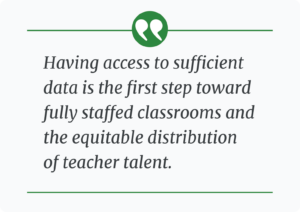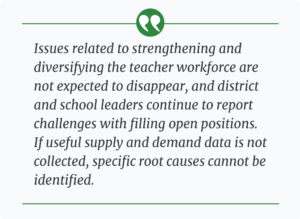by Christina Lemon
Since COVID, media headlines continue to claim there is a teacher exodus brewing, and that American education is in crisis. But do the data support these claims? In December 2021, the National Council on Teacher Quality (NCTQ) stated that having access to sufficient data is the first step toward fully staffed classrooms and the equitable distribution of teacher talent. They further suggest to reach such goals, states should start by collecting and publishing data aligned with these six key best-practices: teacher supply; teacher demand; disaggregated supply and demand to the institution/district, and certification level; teacher shortages; teacher mobility; and aggregated teacher performance date. Only one state meets all six best-practices. A total of five states publish data aligning with four or more of the -practices. Notably, 11 states do not publish any such data.
They further suggest to reach such goals, states should start by collecting and publishing data aligned with these six key best-practices: teacher supply; teacher demand; disaggregated supply and demand to the institution/district, and certification level; teacher shortages; teacher mobility; and aggregated teacher performance date. Only one state meets all six best-practices. A total of five states publish data aligning with four or more of the -practices. Notably, 11 states do not publish any such data.
Teacher Supply and Demand Data
To achieve optimal staffing within Local Education Agencies (LEAs), State Education Agencies (SEAs) should report how many new teachers are entering the workforce, as well as how many vacancies exist at the local level. According to NCTQ, Title II of the Higher Education Act requires institutions to report the number of pre-service teachers enrolled in preparation programs, yet only 32 states make this data public. Additionally, sufficient data on teacher demand should consist of 1) existing teachers in the workforce; 2) vacancy rates; 3) new hires; and 4) teachers working outside their certification area. NCTQ reported that only 16 states publish complete data sets. Further, only 2 states report on teacher shortages in specific localities and identify teacher certification areas resulting in difficulties identifying where supply matched demand.
Teacher Mobility and Attrition
There are many reasons why teachers leave their school, district, or the profession. In a survey of 1,800 teachers in 2022 about their future vocational plans in education, inadequate compensation, unrealistic expectations, and lack of well-being were cited as the top three reasons they would leave their current role. These data, while helpful, do not lead to a complete understanding of the intricacies of local policies and practices. To better understand the ebb and flow within the local educator workforce, data that delineates between teacher mobility (leaving to work in another school or district) and teacher attrition (leaving the teaching workforce) should be reported separately and recorded based on localities. As NCTQ suggested, once these factors are identified, appropriate targeted policies or approaches can be applied. Yet only 20 states publish complete data sets in this area.
Equitable Distribution
A longstanding goal in education has been to increase the diversity of educators and improve teacher effectiveness. Diversity remains a significant challenge, especially as the focus of the teacher workforce pipeline has been on filling vacancies. Only 30 states track teacher demographic information at the school level. A lack of data in this area limits the ability to gain a better understanding of where more diversity is needed, but also which post-secondary teacher preparation programs should strengthen practices to increase diversity within their student body.
Another area for improvement is a more equal distribution of effective teachers. This is one of the main goals set by Every Student Succeeds Act (ESSA) of 2015, that every student should have access to qualified and effective teachers. While there are some drawbacks to this federal law (states have discretion over defining specific requirements such as what it means to be teaching “out-of-field,” and what qualifies as “effective” and “experienced”), the research show that student achievement and teacher quality are inextricably intertwined. Only 13 states report school-level aggregate teacher performance data, and just 20 states report on all three areas; teacher effectiveness ratings, experience, and area of certification.
Change is Needed
Issues related to strengthening and diversifying the teacher workforce are not expected to disappear, and district and school leaders continue to report challenges with filling open positions. If useful data is not collected, specific root causes cannot be identified. Passing blanket policies and enacting general solutions will continue to be ineffective  at addressing the real problems within specific schools and districts.
at addressing the real problems within specific schools and districts.
Carolyn Haug, Director of Research and Impact in the Educator Talent Division with the Colorado Department of Education, suggests a three-pronged approach to providing more comprehensive educator workforce data.
- Become familiar with the state laws on data collection. In some states, SEAs must have the legal authority to collect the necessary data.
- Implement well-planned comprehensive data collection practices. Know what you need to collect, and how to get it.
- Create informative visualizations by gathering stakeholder design input.
Comprehensive Centers can support SEAs in the following ways:
- Become familiar with the health of your states’ data collection practices and policies around data collection. View the recommended Six Best Practices for Teacher Supply and Demand data. Many states support collection of data at the state level, but lack systems to delineate region, district, and school level data.
- Check out the States to Learn From recommendations made in the State Reporting of Teacher Supply and Demand Data by NCTQ (2021). States empower localities when they make teacher workforce data available to regions, districts, and schools.
- Begin conversations with your SEA representatives about what support the Comprehensive Center or other technical assistance center could provide to help the state’s data health.
Christina Lemon, Ed.D., is a consultant at McREL International and former educator, instructional coach, and education leader in innovation, and now works with schools, districts, and SEAs across the US to support improved teaching and learning with an emphasis on quality implementation of evidence-based instructional strategies for diverse learners.

